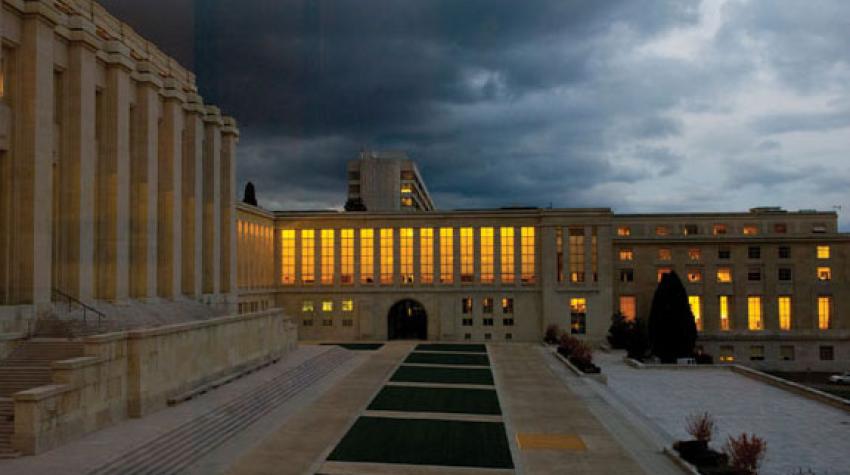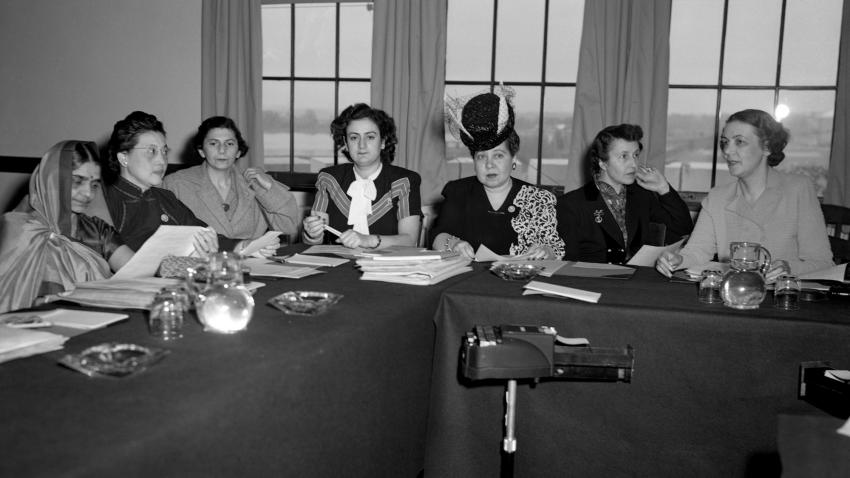December 2016, No. 4 Vol. LIII, Human Rights
“Fifty Years of Success” could be the headline for the anniversary of the adoption in 1966 by the United Nations General Assembly of the International Covenants on Civil and Political Rights and Economic, Social and Cultural Rights. Human rights have been the most dominant driver of change in the post-Second World War period and particularly since the end of the cold war in 1989. In this article I will outline the impact the Covenants have had on the pursuit of human rights worldwide and the path forward at a time when the human rights regime is being challenged.
The world has advanced in many of the areas addressed in the two Covenants, offering greater protections today. Fifty years ago, torture was considered a normal part of police investigation. It is still widespread but is utilized less frequently. More importantly, all actors—police, prosecutors, judges, defendants and citizens—now know that torture is wrong and a violation of human rights. Furthermore, thanks to the International Covenants, the awareness and understanding of discrimination, in particular racial discrimination, is deeper than before. Finally, today it is commonly understood that all children have a right to primary school education. The prohibition against torture and discrimination, and the right to education, have contributed to the creation of a more humane world. This can also be said with regard to most of the rights recognized in the Covenants.
The two Covenants, along with other human rights instruments, established a common language that could be used globally and locally, at all levels of governance. That language allowed for difficult discussions on the death penalty, slavery and gender equality. Without the ability to speak openly about these issues, no changes would have occurred. The two Covenants and other human rights instruments also established a legal framework for international legal scholars and lawyers to develop a new body of law that today is applied on all continents. Until the early 1990s, it was possible to learn all aspects of human rights law. Today, one would be lucky to fully master all aspects of even one of the rights inscribed in the Covenants.
The United Nations human rights treaty bodies have played a key role in this development, in particular the Human Rights Committee and the Committee on Economic, Social and Cultural Rights. Their work has had a direct impact worldwide, leading to changes in national law, policy and practice, as well as bringing redress to individual victims. All States are parties to at least one of the core international human rights treaties, and more than 75 per cent of States are parties to four or more, including the two Covenants.
The human rights treaty bodies offer a unique possibility for a constructive dialogue between States parties to the conventions and the experts on the committees with regard to difficult issues pertaining to specific human rights challenges in the countries. States parties are often reluctant to recognize that they are not in compliance with their obligations. Experience shows, however, that the recommendations from the treaty bodies are considered and addressed in everyday policymaking at the national level.
The treaty body examination also constitutes a platform for an informal exchange between civil society actors, States and experts. This triangle has frequently resulted in new ways to move forward and more prominent engagement of civil society in United Nations work. Unfortunately, it is not always constructive, and too often civil society partners who have appeared before the United Nations suffer severe consequences. Upon returning home, they are sometimes harassed, imprisoned or banned. Such retaliation needs to be addressed firmly, as it erodes the agreed ways of working in the United Nations and undermines attempts to discuss openly realities on the ground.
The Human Rights Committee has been the principal player for many years in developing global human rights jurisprudence. From the late 1960s to 1990, the main institutions developing international human rights law were the Human Rights Committee, the Inter-American Court of Human Rights and the European Court of Human Rights. This body of jurisprudence served as the basis for the development of human rights law that has taken place in the last 25 years. Other regional courts, such as the European Court of Justice and the quasi-judicial African Commission on Human and Peoples’ Rights, have added new dimensions. Nevertheless, the most important developments have occurred at the national level, with national courts around the world applying constitutional and international human rights law to a much larger extent than ever before. The mainstreaming of human rights law into the national legal frameworks has contributed to a richness of human rights jurisprudence.
In this regard, National Human Rights Institutions (NHRIs) should also be mentioned. Whereas in 1990 there existed a mere five NHRIs and only a few equality bodies across the globe, today there are more than 100 NHRIs and a multitude of specialized equality bodies, let alone ombudsman institutions for children and data protection agencies, among many others. Often having quasi-judicial competencies, these actors play a significant role at the national level in implementing international and regional treaties. Their expertise has brought about a higher quality and deeper understanding of human rights norms.
Where does this leave the United Nations human rights treaty bodies, which act as judicial entities dealing with individual communications? From having had a near monopoly in the interpretation of international human rights law, they are now faced with a multitude of courts and quasi-judicial national mechanisms, and high expectations from States parties, authors of communications and the public. What worked for the first 25 years, when the treaty bodies were the only game in town, may not be sufficient today. Their contribution to the development of international human rights law is still needed, but greater coherence and quality is expected of them. This could be remedied by unifying the handling of individual communications, introducing stronger legal procedures and a higher level of professionalism. Valuable experiences from the various regional frameworks, such as the African, European and Inter-American systems, could be harnessed.
The emergence of the Universal Periodic Review (UPR), established concurrently with the Human Rights Council by the United Nations General Assembly in 2006, has changed the institutional landscape most significantly. This procedure relies to a large extent on the work of treaty bodies and other monitoring mechanisms, as well as information from other sources. The UPR has quickly become an important peer review of state performance in the field of human rights. States most often prepare themselves well for the review and may rectify issues that previously have been raised by treaty bodies or special procedures. Many States have established mechanisms to ensure implementation of the recommendations from the UPR procedure. In most countries, the mechanism enjoys greater visibility than the treaty bodies, despite the more superficial nature of the examination.
The Office of the United Nations High Commissioner for Human Rights (OHCHR) is key to pulling all the different dimensions of the United Nations human rights agenda together. The seven high commissioners who have served since 1994 have all become internationally known figures and important voices, bringing to light severe human rights violations. They have—often under very difficult circumstances— acted in an independent manner as a global human rights beacon. At the same time, they have led important discussions at the United Nations Human Rights Council. OHCHR has serviced the treaty bodies and the special procedures, and performed many other tasks. Serving as a convening platform for difficult discussions and important processes is one of the functions that the Office has fulfilled with great skill. Thanks to the facilitating role of the OHCHR, NHRIs developed rapidly in the 1990s on all continents. The number of institutions grew from 5 to 100 within 10 to 15 years. At the same time they obtained a particular status within the United Nations, whereby they broke the exclusivity of States and non-governmental organizations (NGOs) as sole actors in the system. This development was a global engine in human rights implementation, and the Office played a key role in the process.
OHCHR has also been an actor in the field. At times there has been an uncertainty as to where to put the emphasis—in Geneva or in local communities. Whereas no other organization can carry out the tasks that the Office performs in Geneva, this is not the case regarding the capacity-building in the field. In many ways, the specialized development organizations, such as the United Nations Development Programme, are better equipped to do the work in the field when up-scaling their human rights knowledge. Carrying out the double task of capacity-building and monitoring has proven almost impossible. In countries with severe human rights challenges, it is next to impossible to gain the necessary trust that is a prerequisite to working with key authorities, such as ministries of justice, police and judicial systems, and at the same time release critical reports about the performance of these institutions.
In the field, the most convincing work is done at the regional level, providing advice and training to other United Nations bodies, NGOs and governmental officials. From a regional position, the monitoring can be carried out at a distance through everyday interaction. In this capacity, OHCHR plays a key role in ensuring that knowledge about the legal and policy developments building on the Covenants does not stay with an in-crowd in Geneva but reaches people operating on the frontline.
Today, a myriad of other organizations at the regional and international levels do very important work pertinent to many aspects of human rights, including the right to health (the World Health Organization), the right to education (the United Nations Children’s Fund), the right to food (the Food and Agriculture Organization), the rule of law and fair trial by jury (the International Monetary Fund (IMF) and World Bank), etc. They may not have a rights-based approach to their work, but they are often greatly inspired by the decisions and recommendations from the human rights machinery based on the International Covenants. The IMF and World Bank’s human rights conditionality, although not as strong and focused as wished for by human rights constituencies, nonetheless has had an impact in numerous countries. They have sparked important rule-of-law changes and created an environment of openness, allowing civil society actors to raise issues of concern.
For 50 years, the two Covenants have proven their importance in strengthening the protection of human rights around the globe. The level of protection today is without comparison to what it was in 1966. Yet setbacks still occur in many spheres, such as the level of participation of civil society in the process of implementation of human rights norms and standards, freedom of expression, protection of minorities, the rule of law and other issues. Thus, the system that has been so important in strengthening the protection of human rights over the course of 50 years needs to adapt to face current challenges. In this regard it is important to join the efforts of and strengthen the dialogue and collaboration between various organizations. The old institutions, including the human rights treaty bodies, need to adjust their work in view of the many new actors who, in turn, need to ensure that their interventions are based on profound knowledge about the legal and factual elements of the issues at hand. All governance structures, including municipalities, need to be engaged. Only in this way can the international human rights norms continue to provide an open space for dialogue on difficult issues and offer real protection for all people.
The UN Chronicle is not an official record. It is privileged to host senior United Nations officials as well as distinguished contributors from outside the United Nations system whose views are not necessarily those of the United Nations. Similarly, the boundaries and names shown, and the designations used, in maps or articles do not necessarily imply endorsement or acceptance by the United Nations.




